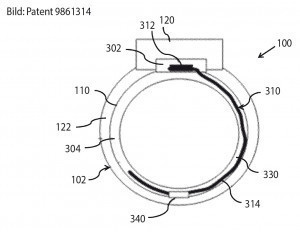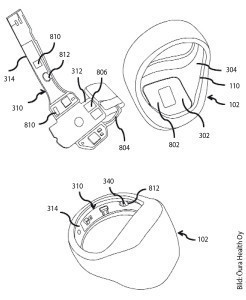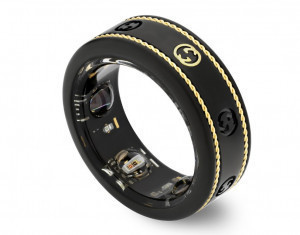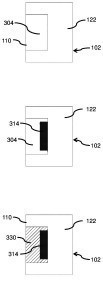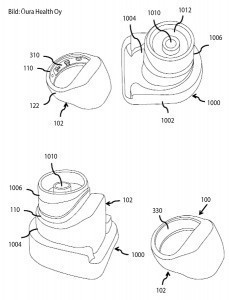The year 2023 is characterized by two anniversaries in the wearables sector: Ten years ago, the first commercially available smart ring appeared and ten years ago, the company 'Oura Health Oy' was also founded. In this relatively short period of time, the latter has made remarkable contributions to the design development of smart rings and their scientifically based application in the sports and medical sector.
Like fitness trackers and smartwatches, smart rings (intelligent rings) are so-called wearables, literally 'wearable' electronics(Fig. 1). The term wearables refers to small networked electronic devices, some with computer functions, which are worn on the body. They are the result of advances in the miniaturization of the component base, in particular integrated circuits, sensors, actuators and batteries. With regard to the latter, it should be mentioned that some types of rings, for example with NFC (near field communication) capabilities, no longer require a battery in certain cases.
The trend towards miniaturization at all levels of electronics is particularly well expressed in smart rings:
- increasing level of integration and decreasing power consumption of ICs
- smaller and more complex sensors with increasing sensitivity
- tiny actuators
- flexible printed circuit boards with further shrinking L/C values (conductor width and spacing)
- miniaturization of batteries with increasing energy storage capacity.
The growing functionality, the increasing precision of the body data measured in the case of fitness rings and their further processing are also an expression of the constant progress in the field of software (health apps) and storage technology (cloud computing). In summary, it can be said that smart rings are a particularly clear reflection of the advances in electronics, software, medicine and sport.
Smart rings
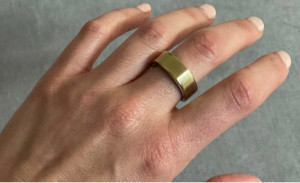 Fig. 2: Inconspicuous: The smart Oura ring on the fingerAtypical smart ring can have motion sensors, haptic actuators, a battery, a Bluetooth or NFC chip depending on the application, an antenna and other components, but not all of them. A flexible circuit board often serves as a component carrier. The rings can communicate with smartphones or other devices, some can work independently, connect to cloud-based systems or perform stand-alone tasks. Although they do not have traditional displays due to their small size, some types have miniaturized displays to provide minimalist status information(Fig. 2). Depending on their purpose, some ring types respond to contextual cues, such as proximity to payment terminals or certain gestures.
Fig. 2: Inconspicuous: The smart Oura ring on the fingerAtypical smart ring can have motion sensors, haptic actuators, a battery, a Bluetooth or NFC chip depending on the application, an antenna and other components, but not all of them. A flexible circuit board often serves as a component carrier. The rings can communicate with smartphones or other devices, some can work independently, connect to cloud-based systems or perform stand-alone tasks. Although they do not have traditional displays due to their small size, some types have miniaturized displays to provide minimalist status information(Fig. 2). Depending on their purpose, some ring types respond to contextual cues, such as proximity to payment terminals or certain gestures.
Although smart rings are still in their infancy, there are already a large number of them on the market today. However, the rings are not (yet) as popular with consumers as smartwatches and fitness bands, although they can be used for a variety of purposes. The most widespread applications are currently in the health and fitness categories. Digital payments, internet security and access control using NFC are other practical applications that are gaining ground because they have a significant future in the context of ongoing digitalization, rationalization and security. Specific applications include replacing credit cards, keys, car keys and, with a little imagination, 'ID cards' or 'driving licenses'.
10-year market anniversary
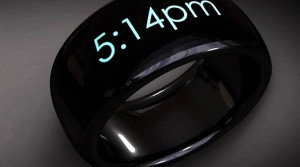 Fig. 3: Smart ring from MOTA with small digital displayThehistory of smart rings is relatively short and intense [1]:
Fig. 3: Smart ring from MOTA with small digital displayThehistory of smart rings is relatively short and intense [1]:
- 2011 - first smart ring concept: in 2011, John McLear presented the first concept for a smart ring with information transmission based on the NFC principle
- 2013 - first practical application: British company Mc Lear officially launched the first commercially available smart NFC ring
- 2014 - Function expansion: Luxury jewelry company Ringly and Mota Doi introduced smart rings with advanced functions such as notification transmission, fitness tracking and more
- 2015 - Mobile payment: Kerv and Token created a smart ring for contactless mobile payment
- 2016 - Global acceptance: The market for smart rings expanded worldwide. Brands such as Oura, Motiv and Logbar gained popularity in different regions
- 2018 - Wearables integration: smart rings are being designed to work in conjunction with other wearables such as the Apple Watch and Fitbit devices
- 2019 - Artificial intelligence (AI) integration: Developers began integrating AI and voice assistant features into smart rings, offering enhanced functionality and interaction options
High growth rates
A look at various market forecasts for the future of smart rings reveals widely diverging figures and values in terms of market scope. Here are two examples: In [2], it is estimated that market growth (CAGR) of 21.39% per year is possible in the period 2022-2027. Global sales are expected to increase by USD 34.4 billion in 2027 compared to 2022. In 2017, the market still amounted to USD 8.49 billion. In [3], a CAGR of 20.8 % is assumed from 2023 to 2030. For 2021, the market was estimated at $4.10 billion, while $22.49 billion was forecast for 2030. It is unclear whether these figures only take into account the pure hardware or whether the market researchers also included the extended analysis and data storage options provided in addition to the comprehensive practical use of the rings. The latter can be subscribed to as an additional pay service with some providers, such as the Apple, Samsung or Oura health app.
What all market estimates have in common, however, is the average annual growth rates of over 20 %. The decisive role of IoT and the cloud in realizing these assumptions is emphasized. The unanimous statement that smart rings are "the market of the future" is important. The market share growth of the Bluetooth-enabled smart ring segment will be significant during the forecast period. However, a Bluetooth-enabled smart ring cannot be a standalone product and must be paired with a smartphone to fully perform its functions or tasks. Operating systems such as Android, iOS and Windows are compatible with smart rings. In addition, the integration of AI and more advanced notification features are expected to boost the growth of this market segment during the forecast period. Among the top 20 smart ring manufacturers in the world listed in [2], Oura Health Oy is also listed. It is presented in more detail below.
Oura Health Company
The Finnish 'Oura Health Company' was founded in 2013 and is based in Oulu. Other locations are Helsinki and San Francisco. The existence of the company and its scientific and technical concept is thanks to three women: Petteri Lahtela, Kari Kivelä and Markku Koskela [4]. The company achieved extraordinary things in the ten years of its existence:
- It managed to become world-famous for its main product, the intelligent Oura ring, and the extensive achievements based on it
- It made a significant technological and constructive advance in miniaturized electronic wearables products
- It made a significant contribution to individual health monitoring and health research worldwide.
The 10th anniversary of both the founding of Oura and the release of the first marketable smart ring from Mc Lear are an occasion to take a closer look at the Oura company, the Oura ring and the international development in the design of such wearables inspired by it. But first, we will explain why the Oura ring effectively filled a gap in the market and what the consequences were.
Starting point: all about sleep
Sleep is the crucial foundation for mental and physical health. For this reason, the newly founded company began in 2013 to look into the methodology of recording sleep data, sleep tracking and the evaluation of this data in a special app on the one hand, and to look for ways of technically realizing the recording using miniaturized electronics close to the body on the other. The technical result was the Oura ring for the finger, from which the recorded data is transferred to the app on the smartphone.
Because sleep quality is inextricably linked to physical performance during the day, the aim was to establish a connection between the measured sleep characteristics and the various physical activities, which are also recorded digitally, in order to draw conclusions about the body's readiness to perform. Competitive and endurance athletes, for example, can draw important information from this for their training planning. Activity tracking was carried out for over 30 different physical activities, including the most important popular sports. Generally speaking, the company's approach was no different to that of the large number of smartwatch manufacturers from Apple to Fitbit.
As a result of combining all the data recorded with the Oura Ring in the app, the Oura Readiness Score is provided to the test person on their smartphone, which gives them an indication of the physical exertion they can 'afford' at certain times in order to optimally challenge their body or not overtax it. In this respect too, the Oura Health Company's approach is similar in principle to some smartwatch providers. However, the Readiness Score takes into account over 20 different body signals - including temperature, heart rate, HRV (heart rate variability) and sleep - and uses these to derive exercise recommendations for the day ahead.
On the scientific path
Continuing to collect and analyze the body's personal situational data, the company has developed an entire philosophy for managing both mental and physical stress, which has its practical core in a growing library of audio wellness sessions. There are currently over 50 different audio sessions for meditation, sleep, concentration, energy boosts and more [4]. They have been created in collaboration with scientific institutions and content partners in numerous countries, including Sweden, Finland, the USA and Israel. The numerous publications on research with the Oura ring, for example in the National Library of Medicine (USA), prove that with its technical realization and subsequent continuous further development, it has in fact decisively prepared the ground for a new type of broad application of miniaturized ring wearables in the private and institutional health sector, the end of which is not foreseeable due to, for example, new even more precise sensors and refinement of the measurement methods themselves. Examples can be found at [5].
Even in scientific research on real-time infection prediction for corona diseases, which was carried out in both civilian and public research institutions in the USA (Defense Innovation Unit, Philips Research North America, The Guthrie Clinic, University of California, etc.), the Oura ring was successfully used [6]. This suggests that the scientific validity of the results obtained with the Oura ring now outstrips the results obtained with smartwatches [7]. One reason for this may be that the sensors of the Oura ring are distributed around the finger, in contrast to the smartwatch, where the sensors are only located in one plane on the arm. Nevertheless, it is repeatedly pointed out that the Oura Ring is not yet a validated medical device and only provides predictive health information. However, a March 2023 publication by Oura Healths USA Ltd. itself states that the results of a study indicate that commercial wearable technology such as the Oura Ring is a potential platform on which to develop screening tools for the early detection of diseases, including COVID-19 breakthrough cases [8]. The company has therefore set its sights high for the future.
Incredible flight of fancy
The first-generation ring was launched in 2015 via Kickstarter (a US non-profit organization) after the company received initial seed funding of $3.2 million from Lifeline Ventures as the basis for its work. The second generation followed in 2018 and the third in 2021 - each with improved technology.
In 2020, 'Oura Health' received the 'Best Consumer Wellness Company' award from the UCSF Digital Health Awards and Time Magazine's '100 Best Inventions of 2020' award, with particular mention of its COVID-19-related partnership with the NBA.
The extent of the Finnish company's activity in the race against growing competition can be seen below: Oura Health announced a $100 million Series C financing from a US consortium in May 2021. In May 2023, Oura Health Oy acquired the technology startup 'Proxy', which produces digital identification tools. The company appears to be taking a very ambitious approach to its goals. After all, more than 1 million rings had been sold by March 2022.
Extensive patent basis
Although the Oura ring does not look like it, numerous technological, physical and medical engineering problems had to be solved for its technical and application-specific realization. This is reflected in a whole series of patent applications filed by the company from 2015 to the present day. The Patents [9] section of the US Justitia Company website lists a number of patents held by Oura Healths Oy that were filed in the USA between 2015 and 2022 and granted between 2018 and 2023 [10]. The patents deal with technical or medical details of the realization of individual functions of the Oura Ring as well as with basic principles of its construction.
Patent examples:
- Ring - patent number: D811260 (filed July 2015)
- Wearable electronic device and method for manufacturing thereof - Patent number: 9861314 (filed August 2015)
- Chargeable device and charger thereof - Patent number: 9997945 (filed November 2015)
- Method and system for defining balance between physical activity and rest - Patent number: 10105095 (filed November 2015)
- Arrangement for a photodetector circuit for low power applications, and a corresponding method and a computer program product - Patent number: 11152930 (filed April 2019)
- System and a method for indicating information representing battery status of an electronic device - Patent number: 11075538 (filed April 2019)
 Fig. 4: Basic shape of the Oura ring according to patent D811260Itis alsointerestingto see in which patent classes the first two patents mentioned above (basic patents for the construction of the ring) were classified in the USA:
Fig. 4: Basic shape of the Oura ring according to patent D811260Itis alsointerestingto see in which patent classes the first two patents mentioned above (basic patents for the construction of the ring) were classified in the USA:
- U. S. Class: Casting Metal Introduced Into Mold As A Solid (164/80)
- International Classification: A61B 5/00 (20060101); A61B 5/024 (20060101); B28B 1/24 (20060101); G06F 1/16 (20060101); A61B 5/01 (20060101);
Figure 4 shows the basic design of the ring at the time, as shown in patent D811260. Figure 1 contains a basic exploded view that clearly shows the ring structure.
Due to the constant further development of the component base and the scientific and medical basis for the practical application of the Oura ring since its first market launch in 2015, the progress has been secured in further patents, in particular the US patent 10893833 (filed December 2017, patent granted January 2021) as a follow-up patent to 9861314. It is also entitled 'Wearable electronic device and method for manufacturing thereof' like the patent of the same name from 2015 [11]. Here, however, the material basis for the ring base material is expanded to include a moldable non-ceramic material, for example.
Oura Health Oy provides a larger overview of the patent basis for the ring itself and the apps developed on [12], but points out that the list of Oura's products and patents given there is not complete. For example, further patents may have been registered or granted in the USA, Finland or other countries.
Basic design and manufacture of the Oura ring
Patent 9861314 with the translated title 'Portable electronic device and method for its manufacture' from August 2015 serves as the basis for the description of the construction of the Oura ring. Both the verbal description and the images are taken from there [13]. For reasons of space, only excerpts from the detailed description contained there can be reproduced here. In the abstract, the ring is described in the translated 'patent language' as follows:
A portable electronic device for analyzing and processing biological signals comprising a molded body portion of a moldable ceramic material having an inner surface, an outer surface, and at least one cavity having a recess disposed on the inner surface of the body portion, an electronic portion being located in the cavity, the electronic portion having a thickness less than the depth of the cavity, and a coating of an epoxy material on the inner surface of the body portion covering the electronic portion and the cavity.
The cross-sectional drawing in Figure 5 shows how the electronic assembly is arranged in the cavities. Figure 6 shows the natural view of a third-generation Oura ring from 2021, where part of the installed electronics can also be seen very clearly. Figure 7 shows a schematic representation of the electronic assembly and its arrangement in the ring, as contained in patent 9861314. Comparative images of competing products to the Oura ring show - superficially - clear design similarities, but also differences(Fig. 8).
Fig. 8: Comparison images of rival products to the Oura ring: Gucchi (left) and RingConn (right); Image: Ōura Health Oy / Gucci / RingConn
Incidentally, the Gucchi jewelry ring from Oura costs around $ 950, the simple Oura ring costs € 330 to € 500, depending on the material of the ring surface (from silver to gold).
Some patent details on the materials used and the technological process of inserting the electronic part will be described shortly. Figures 9 and 10 from the patent illustrate some of these details.
- The moldable ceramic material is selected from a group of materials consisting of zirconium, aluminum nitride, aluminum oxide, boron carbide, silicon carbide, silicon nitride, titanium diboride and yttrium oxide
- The electronic part is fixed to the cavity by a fixing means arranged at the bottom of the cavity
- The fixing means is selected from a group consisting of a sticker, an adhesive tape, adhesive and a fixing structure made in a molded body part
- The moldable filler material (for covering the cavity and the electrical part) is selected from a group of materials consisting of at least epoxy material, polyethylene, polyurethane, low temperature molding material, Loctite M-31CL, alpha epoxy, 1,2-epoxy, EpoxAcast 650, bisphenol S epoxy resin, novolac epoxy resin, aliphatic epoxy resin, and glycidylamine epoxy resin
- The electronic part comprises a battery, an infrared transmitter, microcontroller, radio frequency transceiver, temperature sensor and infrared receiver
- To arrange an electronic part in the cavity, its inner surface is coated and the part is then fixed in place using an assembly guide element. Furthermore, two additional cavities are created on the inner surface of the body part, with the battery being placed in the first and the circuit carrier in the second
- In the final step, the entire cavity is sealed using UV-curable epoxy resin
Fig. 9:
Excerpts from patent 9861314
on the production steps of the
Oura ring
Fig. 10:
Molding stand as an installation aid
for the electronic circuit
in the ring
It should be added here that the above-mentioned follow-up patent 10893833 (filed December 2017, patent granted January 2021) is supplemented by the following examples of non-ceramic materials for the base body of the ring: Plastic, metal (such as titanium, steel, platinum, gold, palladium, silver or bronze or a gold-based alloy), rubber or any combination thereof. Accordingly, the shaping processes for producing the ring body and cavities have also been expanded: cutting or milling. Taking into account the fact that smart rings have increasingly developed into decorated jewelry elements in recent years from a jewelry technology perspective, this was added to the patent: Furthermore, the outer surface can be shaped or finished by milling or polishing or other metal workshop processes. This was the Finnish company's response to the diversifying international material and design basis for smart rings.
Growing number of functions
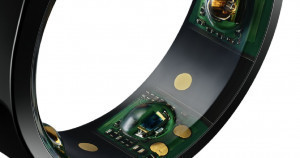 Fig. 11: Sensor element in the Oura ringThefunctionality of the Oura ring is based on infrared LEDs and NTC sensors. Figure 11 shows a slightly enlarged view of the transparent capped sensors in the Oura ring. The light from the IR sensors is reflected by the skin and the changes in the reflection are analyzed by the algorithms developed by the company. This allows the heart rate and heart rate variability to be determined. The sensors capture the wearer's biometric data at a significantly higher sampling rate (250 times per second, 99.9% compliant with conventional medical ECG) than wearables from competitors such as Apple and Fitbit. The device was equipped with additional functions in the third ring generation released in October 2021 and now includes the following hardware
Fig. 11: Sensor element in the Oura ringThefunctionality of the Oura ring is based on infrared LEDs and NTC sensors. Figure 11 shows a slightly enlarged view of the transparent capped sensors in the Oura ring. The light from the IR sensors is reflected by the skin and the changes in the reflection are analyzed by the algorithms developed by the company. This allows the heart rate and heart rate variability to be determined. The sensors capture the wearer's biometric data at a significantly higher sampling rate (250 times per second, 99.9% compliant with conventional medical ECG) than wearables from competitors such as Apple and Fitbit. The device was equipped with additional functions in the third ring generation released in October 2021 and now includes the following hardware
- Green and red LED, in addition to infrared (IR) LED. This enables measurements of daily and training heart rate
- Extra negative temperature coefficient (NTC) sensors with 0.1 °C accuracy to measure differences in skin temperature. This enables cycle indications and improved disease detection. A total of seven temperature sensors are used
- Additional IR sensor that helps the algorithm to detect and compensate if the ring is not optimally aligned, enabling more accurate readings
- 3D acceleration sensor to measure daily activity and steps and to recognize common exercise types
- Color-coded LED for improved indication of charge status.
There is also a new state-of-the-art sleep staging algorithm. Together with the high quality achieved by the algorithm, the Oura ring should even offer an alternative to PSG (polysomnography) sleep studies. There is a scientific publication [15] on PSG studies in healthcare facilities based on the multi-sensor approach of Oura Health Oy with its new ring.
The ring can store the data collected for a week without contact with the smartphone. A full battery charge takes 20-80 minutes, depending on the initial situation, and should last for an average of one week. The ring weighs 4 - 6 g depending on the ring size. Further details on the technical data and materials as well as the software features can be found at [14]. With the introduction of the Generation 3 Oura ring, Oura has switched to a monthly subscription membership. Users of this ring without a membership can only access the results of the current day, without insights or additional functions. The future will show whether such usage models will prevail in the future, despite further technical improvements to the rings, as there has been criticism from customers about the manufacturer's approach.
References
https://asmartrings.com/history-of-smart-ring (accessed: 10.12.2023).
www.technavio.com/report/smart-rings-market-industry-analysis (Retrieved: 10.12.2023).
www.verifiedmarketresearch.com/product/global-smart-ring-market-size-and-forecast-to-2025/ (Retrieved: 10.12.2023).
https://ouraring.com/ (Retrieved: 10.12.2023).
https://pubmed.ncbi.nlm.nih.gov/28323455/ (Retrieved: 10.12.2023).
https://osher.ucsf.edu/news/51m-awarded-tempredict (Retrieved: 10.12.2023).
https://bmcmedresmethodol.biomedcentral.com/articles/10.1186/s12874-023-01868-x (Abruf: 10.12.2023).
https://karger.com/dib/article/7/1/1/836574/Feasibility-of-Measuring-Physiological-Responses (Retrieved: 10.12.2023).
https://company.justia.com/ (Retrieved: 10.12.2023).
https://patents.justia.com/assignee/oura-health-oy?page=2 (Retrieved: 10.12.2023).
https://patents.justia.com/patent/10893833 (Retrieved: 10.12.2023).
https://ouraring.com/de/intellectual-property-notice (Retrieved: 10.12.2023).
https://patents.google.com/patent/US9861314B2/en (Retrieved: 10.12.2023).
https://support.ouraring.com/ (Retrieved: 10.12.2023).
www.mdpi.com/1424-8220/21/13/4302 (Retrieved: 10.12.2023).


